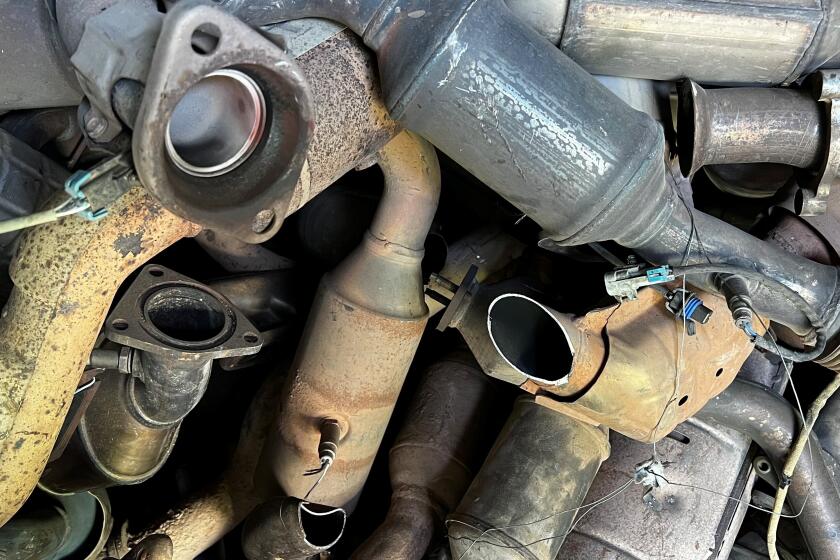BART restores service after computer glitch shuts down entire train system, stranding thousands

- Share via
SAN FRANCISCO — Thousands of commuters across the Bay Area found themselves stranded at train stations during the peak hours of Friday’s morning commute after a computer issue knocked out service to the region’s most heavily used train system.
The massive shutdown of the San Francisco Bay Area Rapid Transit (BART) system lasted more than four hours, the worst such public transit meltdown to hit the area in recent memory. It created a wave of traffic across the Bay Bridge, surging prices on rideshare apps and sent ferry companies scrambling to manage a crush of new passengers moving between San Francisco and Oakland for work and school.
BART trains, which typically begin running at 5 a.m., remained shuttered until just after 9 a.m. BART spokesperson Alicia Trost said the train’s control system “couldn’t power up correctly” early Friday, causing the systemwide closure.
“Without [the train control system], we can’t run trains safely,” Trost said in a statement. She said transit system operators were still working to understand the “root issue” of the control system glitch.
Commuters were stunned to find their local BART station gates shuttered early Friday, some wrapped in yellow caution tape. Many scrambled to make alternate arrangements, though few found options that weren’t drastically more expensive or time-consuming. BART’s heavy rail line, which connects five of the region’s most populous counties and ties together San Francisco with Oakland, sees about 184,000 paid trips per weekday, according to an average calculated over the last month.
When J.D. Chilton was dropped off at the Bay Fair BART station for his usual 5 a.m. train, he and several others waiting outside were shocked to find the train station was completely closed.
“Kind of surreal,” Chilton, 43, said. Many around him seemed almost dumbfounded, he said, as if they were thinking, “I don’t understand. How is this happening?”
Chilton said he immediately let his boss know he was going to be late for work in Daly City across San Francisco Bay, before walking home to get his car and drive over the San Mateo-Hayward Bridge — something he hasn’t done in a while.
“It was pretty heinous,” Chilton said. Instead of arriving at around 6 a.m. as he normally does, he got there around 8:30 a.m.
One person on X posted that his Uber from Oakland to San Francisco International Airport was estimated to cost $85 around 7:30 a.m. after he realized the train wasn’t an option. Someone else commuting from Oakland into San Francisco posted on Facebook that she might not make it into work at all.
Just before 4:30 a.m. Friday — about a half hour before trains typically begin running — officials warned that all trains were “suspended systemwide until further notice,” BART officials shared in an early morning alert. Later, officials called it a “computer networking problem,” and urged riders to “seek alternate means of transportation.”
BART officials encouraged riders to find transportation alternatives on its site, which appeared to recommend nearby bus lines.
A host of the region’s transit agencies tried to come to the aid of commuters. The San Francisco Bay Ferry system put its largest ferries into service and urged people needing transport from Oakland, Alameda, Richmond and Vallejo to take them. AC Transit, the bus system for the East Bay, was transporting buses filled with passengers over the Bay Bridge into the Salesforce Transit Center. Caltrain, the commuter rail line that links San Francisco with the Santa Clara Valley, said it was providing “mutual aid” to BART, honoring valid tickets and passes.
But Friday’s major shutdown was only the latest challenge for BART, which, like all the Bay Area transit systems, has struggled to regain ridership since the COVID-19 pandemic. The system has also struggled to combat perceptions of a lack of safety and concerns about cleanliness, and is facing financial shortfalls as federal and state emergency funding is about to expire.
BART general manager Robert Powers apologized for the disruptions Friday morning but said they were necessary to ensure safety.
“We will learn from this incident and are committed to continuous improvement,” Power said in a statement. “We are grateful to our partner transit agencies who were able to help our riders this morning.”
State Sen. Scott Wiener (D-San Francisco) said the train meltdown Friday only emphasizes how vital BART and public transit are to the region, and why such systems must receive the funds they require.
“Today’s BART’s shutdown — & the resulting traffic, transit & work disruptions — are another reminder of how essential BART & other transit systems are for the Bay Area,” Wiener wrote on social media site Bluesky. “BART & other systems face devastating service cuts if we don’t shore up their funding. ... We must act to save these systems.”
BART in January raised fares by 5.5% to keep pace with inflation, with the average fare now $4.72, up from $4.47. But that uptick is far from covering major budget shortfalls or helping the transit system prepare for long-term stability.
The system, however, has cited some recent wins, primarily in its efforts to increase ridership. After several recent improvements aimed at improving safety and cleanliness — including replacing some decades-old train cars, installing more robust fare gates and adding elevator and bathroom attendants — BART said violent crime on the transit system fell by 23% during the first three months of the year, compared to the prior year. There was a 17% decline in overall crime in 2024.
In 2024, BART reported 50.6 million passenger trips, up 5.3% from the prior year. But weekday BART station exits were still at less than half of what they were in 2019, the last calendar year before the pandemic.
Trost, the BART spokesperson, did not respond to questions from The Times about if the issue that occurred Friday had happened before or was likely to happen again. But in comments to television reporters, she referred to a similar problem that prevented BART from opening up on time in 2019, in which it took five hours for trains to be fully operational.
Then, BART also experienced a systemwide meltdown, but the effects were much less widespread because it occurred on a Saturday. The event was caused by a single network switch that failed, which led to a cascading failure that broke the communications line between BART’s operations control center and its systems and devices in the field, according to BART. Trains didn’t reach full service that day until about 11 a.m.
While Trost said BART has since replaced many of its network devices — part of an update to infrastructure after voters approved the $3.5-billion Measure RR bond measure in 2016 — she said in an interview with KTVU-TV Channel 2 that it’s not clear whether Friday’s failure “even has anything to do with ‘old’ versus ‘new.’”
“We’re also still looking into knowing, ‘Do we even need to make a repair or replacement?’ Or is this some other type of connectivity issue?” Trost said.
Prior to 2019, the last major BART disruption of this kind occurred in March 2006. Then, an attempt to work on a backup system inadvertently resulted in a hardware failure, bringing all trains to a halt for an hour during the peak of a Wednesday evening commute. Officials in 2006 said later they shouldn’t have been working on that system while trains were running with passengers.
For Chilton, the worker who was forced to drive into work Friday, his biggest concern now is making sure he doesn’t forget his evening commute will be by car.
“Hopefully, I don’t have a brain fart and get on the train,” Chilton said.
More to Read
Sign up for Essential California
The most important California stories and recommendations in your inbox every morning.
You may occasionally receive promotional content from the Los Angeles Times.












